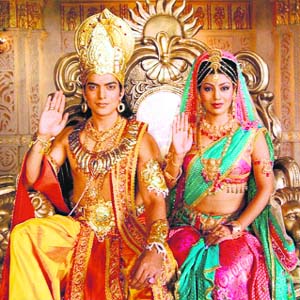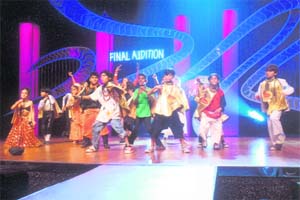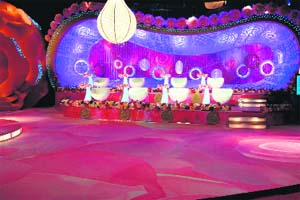|
SET TO SIZZLE
An imaginative set
is as much an integral part of good programming as the script
and acting. Hence, television producers are digging deep into
their pockets for elaborate set designs, writes Neerja
Bahadur
|

Every channel is demanding tastefully done-up sets, leaving producers with no choice but to spend liberally on this hitherto neglected aspect of TV programmes
Photo courtesy: Imagine
|
|

A set that involves a lot of detailing can cost anything between
Rs 10 lakh and Rs 20 lakh
|
|
Designing
goes digital
Thanks to
computers, storyboards sketches will soon become a thing
of the past. Set designing is fast turning into a digital
art with special effects being created on monitors. Once
the sole preserve of Hollywood, digitally produced set
designs are fast becoming commonplace in television and
films, thanks to IT professionals and creative animators. |
|

Set designers have been elevated to the status of art directors, who can make or mar a programme
|
|
Setting the
trend
Nitin Desai
is one of the most successful television and film set
designers, who created the sets of Kaun Banega
Crorepati,
Big Boss and
Jhansi Ki Rani in
his 52-acre ND Studio in Navi Mumbai. Though Desai has
done countless serials, after he did the designing for Slumdog
Millionaire, he is so much in demand in films that he
has become selective about work on television. Sets of
serials like Chittod Ki Rani Padmini Ka Johur, Bajirao
Mastani and the historic TV series, Taj Mahal, have
also been created by Desai. |
|

|
|
Despite the glamour and big money-earning potential, the profession has its own hurdles. For instance, there are constraints of space to effectively fabricate and ideally put up the whole set before it moves into the studio |
HOW times change.
Back in the 1980s, a suite in a five-star hotel could pass off
as a prosperous household setting for a family serial. But there
was only one caveat. Such an elaborate set came at a price tag
of around Rs 5,000 or more a day — a sum that only a handful
of producers could afford.
Then came Ramanand
Sagar’s hugely successful Ramayana. Its gripping
storyline, characterisation and energy mesmerised the entire
nation. But the riveting mythological series lacked a vital
element — ornate sets. The appeal was somewhat diminished by
its garish costumes and amateur settings. Though Sagar continued
to make super-hit religious serials like Uttara Ramayana,
Shri Krishna and Jai Ganga Maiya, he, apparently, did
not believe that sets could enhance the value of epics, which
had a strong storyline.
But B. R. Chopra
thought differently. When he launched Mahabharat, he
hired a team of top professionals to do the sets in as credible
a way as possible. Sketches were made of all-important
situations in the serial and a thorough research was conducted
for the interiors of houses and palaces and for the backdrops of
battlefields. In fact, no expense was spared to give the serial
an edge of authenticity. And the results were there for all to
see — Mahabharat went on to smash all viewership
records and changed the way people watched TV shows.
Ever since then,
set designers have been elevated to the status of art directors,
who can make or mar a serial with their sets. Vishal Jain, a
serial producer, puts it aptly when he says, "A good set is
something that enormously adds to the appeal of a show but you
seldom notice it."
Megabuck sets
Today, producers
are paying megabucks for elaborate sets that have given a new
dimension to shows and serials like The Sword of Tipu Sultan,
Kaun Banega Crorepati, Indian Idol, etc.
Ask anyone why he
or she liked a particular TV show, and you would get a variety
of answers ranging from a good storyline to powerful
performances or even great photography. But not a word about the
great sets. Pity. Because an imaginative set is as much a part
and parcel of good programming as the script and acting.
Since television
is a visual medium, every show — from a serial to a musical
countdown and from a newsbased programme to a chat show —
requires the vital inputs of a good set designer.
"There is no
serial or show, which does not involve a design component,"
says Mumbai-based set designer Vishal Mehta. "These days,
sets are made in a way they can easily be taken down and stored
and then put back because all episodes won’t be shot in one
spell."
Lavish designs
In these fiercely
competitive times, when every channel is vying for the numero
uno position, a welldesigned set assumes great importance.
Producers, worried about TRP ratings, are digging deep into
their pockets to spend on lavish sets in a bid to heighten the
effect of their shows.
Most of the sets
are made to suit the content of the programme, says Varsha Jain,
who is designer for serials like Laagi Tujh Se Lagan (Colors)
and Daag. Incidentally, she is one of the very few women
set designers in a profession dominated by men, and has studied
fine arts in New York with a special course in theatrical set
design.
Another name to
reckon with in the profession is that of Omung Kumar, who has
designed sets for such hit serials as Guzaarish and Chance
Pe Dance. He has now become a big name in films as well,
with Saawariya, Black and Ishq Vishk in his kitty. He
says Bollywood films and Indian TV shows have some of the most
elaborate and creative sets in the world.
What exactly are
the basic requirements of set designing? "A designer has to
be very imaginative. He has to comprehend a show completely
before constructing a set," says Vishal Mehta. "You
have to know things like the movement of the story, the
choreography and how many people are there in one particular
show. Then comes the technical aspect like how much space is
there and what kind of material is to be used. A set designer is
very close to an architect."
Art of
conceptualising
A designer’s
work begins at the inception stage of a programme. It is an art
of conceptualisation. During story sessions, his imagination
starts ticking. He breaks the show into scenes and details down
each set usually on a drawing board. Most set designers make
sketches of each scene. "Unless you do this exercise, you’ll
never be able to make good sets," says Mehta.
Good lighting,
too, plays a major role. Although it may not affect the actual
design, it can certainly enhance the look of a set.
What kind of costs
are involved in making a set? According to Mehta, if a producer
wants to spend the minimum and doesn’t value the artistic look
of the programme, it could be done under a lakh of rupees.
"But a swank set involves a lot of detailing and can cost
anything between Rs 10 lakh and Rs 20 lakh."
Professional
hazards
But despite the
glamour and big money-earning potential, the profession has its
own hurdles. For example, there are constraints of space to
effectively fabricate and ideally put up the whole set before it
moves into the studio. "It is a mad race against time to
get it up and ready," says Mehta, and adds, "Sometimes
when a designer is not given enough time, then he or she starts
cutting corners, and that’s when tensions arise."
The other
important aspect of the profession is to understand the producer’s
mind. Once everything is discussed, the designer should be left
alone so that he can create a good set. "A producer must
understand that he’s hired a professional and should not
interfere in his job after the initial ground rules have been
laid down," says Mehta.
Though
interference is a part of the occupational hazards, now with the
channel wars hotting up, producers have started realising the
paramount role of a set designer. Every channel is demanding
tastefully done-up sets and shows like Kaun Banega Crorepati,
Big Boss and Indian Idol and have set new benchmarks,
leaving producers with no choice but to spend liberally on this
hitherto neglected aspect of TV programmes. — NF
|